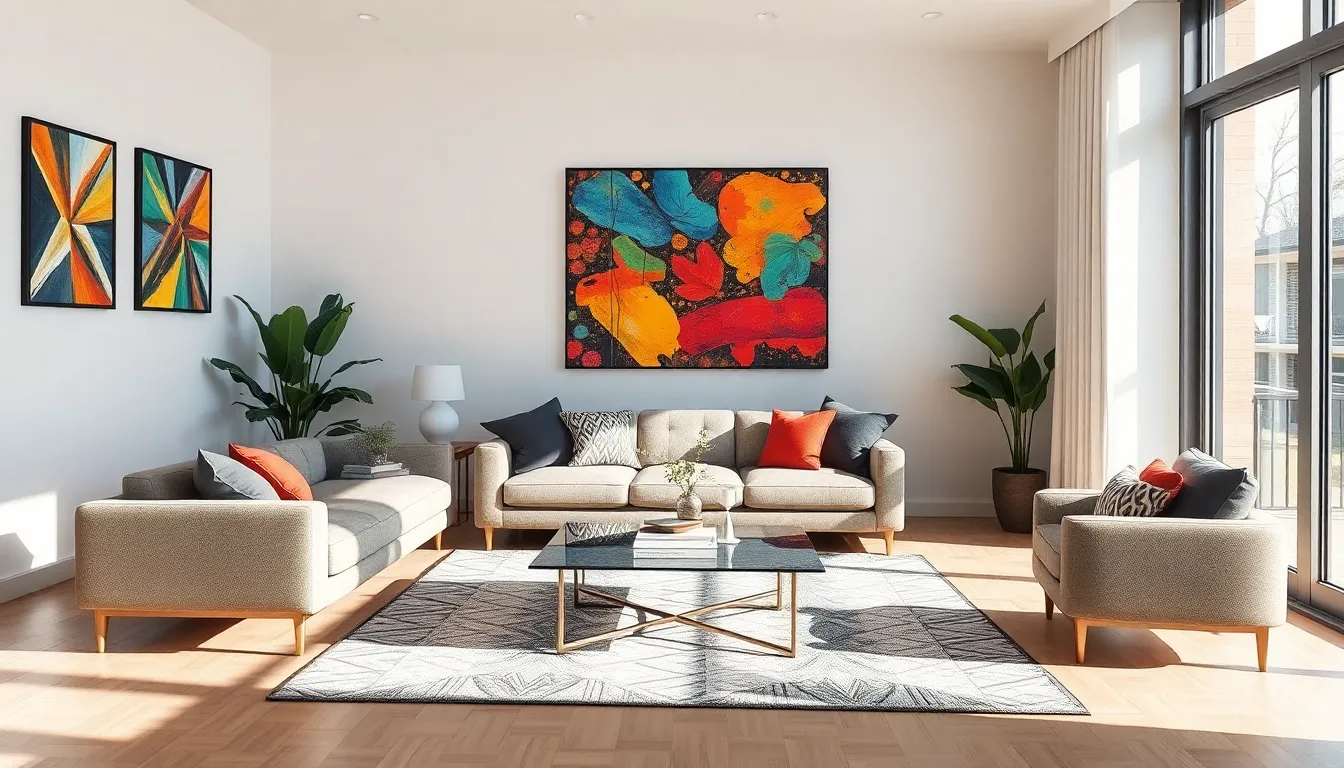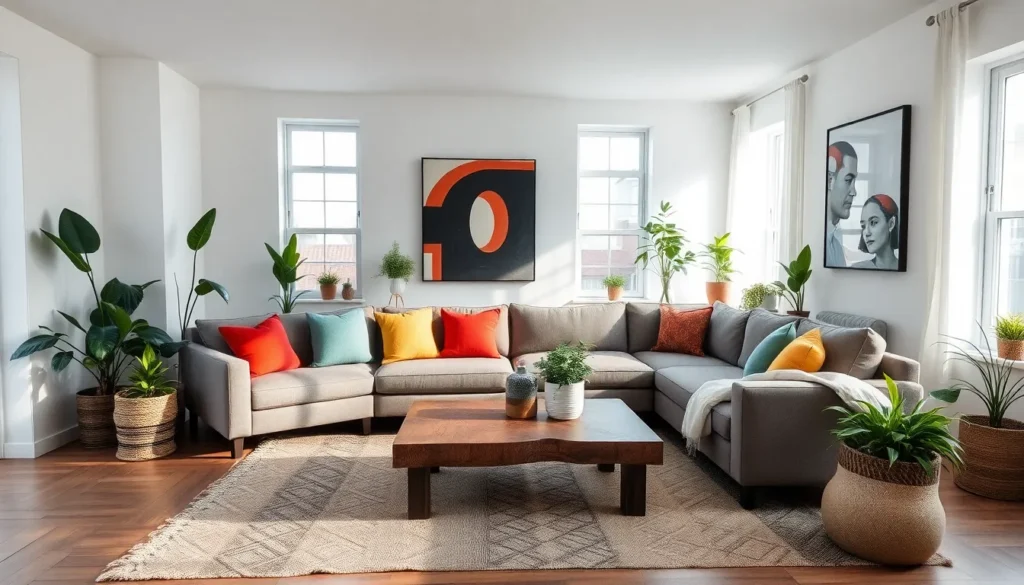Interior design isn’t just about aesthetics; it’s a powerful way to transform spaces into functional and inviting environments. From cozy homes to sleek offices, the right design can enhance mood, productivity, and overall well-being. As people spend more time indoors, the demand for thoughtful and innovative design solutions continues to grow.
With a focus on blending style and functionality, interior design plays a crucial role in creating spaces that reflect personal tastes while meeting practical needs. Whether it’s embracing minimalism or opting for bold colors and patterns, the choices made in interior design can significantly impact how a space feels and operates. Understanding the principles of design can empower anyone to make informed decisions that elevate their surroundings.
Table of Contents
ToggleOverview of Interior Design
Interior design encompasses the process of shaping the experience of an interior space through the arrangement of elements like color, furniture, lighting, and decorative objects. It integrates function and aesthetics to create environments that ensure usability alongside visual appeal. Design professionals consider various factors during the design process, including space planning, human behavior, and architectural integrity.
Interior design also reflects trends, cultural influences, and individual preferences. Different styles—such as contemporary, traditional, minimalist, and industrial—offer diverse approaches to achieving desired atmospheres.
Additionally, sustainability plays a crucial role in modern interior design. Many designers focus on eco-friendly materials and practices, reducing the environmental impact of their projects.
The significance of interior design extends to commercial spaces as well, enhancing employee productivity and customer experience. Thoughtful designs contribute positively to mood, often resulting in improved functionality and user satisfaction.
Key Elements of Interior Design

Interior design encompasses several key elements that contribute to the overall effectiveness and appeal of a space. Understanding these components allows for informed design choices that enhance aesthetics and function.
Color Schemes
Color schemes influence mood and perception within a space. Designers often use complementary, analogous, or monochromatic palettes to create harmony. For example, a combination of blues and greens fosters a calming atmosphere, suitable for bedrooms and offices, while vibrant reds and yellows invigorate spaces like kitchens and dining areas. Choosing colors based on the intended purpose of a room promotes an engaging environment.
Furniture Selection
Furniture selection plays a crucial role in balancing style and function. It’s essential to choose pieces that align with the space’s scale and the intended use. Overly large furniture can overwhelm a room, while too-small items may feel lost. Additionally, diverse materials and textures in furniture—like wood, metal, and upholstery—can add interest and depth. For instance, incorporating a mix of modern and vintage pieces can create a unique character, reflecting individual tastes and complementing design styles.
Space Planning
Space planning involves strategically arranging furniture and decor to maximize functionality and flow. Effective space planning considers traffic patterns, focal points, and the functional relationship of items within the area. For instance, an open floor plan benefits from clearly defined zones for living, dining, and work areas. Using visual markers, such as rugs or lighting, can delineate these spaces while maintaining openness, ultimately enhancing usability and comfort.
Popular Interior Design Styles
Interior design styles significantly influence the ambiance and functionality of spaces. Here are some of the most popular interior design styles.
Modern
Modern design emphasizes simplicity and clean lines, often featuring neutral colors paired with bold accents. Space utilization highlights minimalism, reducing clutter and focusing on open layouts. Incorporation of innovative materials, such as glass and metal, enhances the aesthetic appeal. Furniture tends to have geometric shapes and low profiles, creating a sleek atmosphere. Designers often opt for statement pieces, like oversized art or sculptural furniture, to draw attention.
Traditional
Traditional design draws inspiration from historical styles, showcasing rich colors, ornate details, and classic furnishings. Elements like wood paneling, crown molding, and gilded accents create a sense of elegance. Fabrics often include luxurious textiles, such as silk and velvet, while patterns like florals or damasks add personality. Symmetry plays a vital role, with furniture arranged in balanced configurations to reflect formal aesthetics. Traditional lighting fixtures often feature chandeliers or sconces, enhancing the sophisticated climate.
Eclectic
Eclectic design celebrates individuality by blending various styles, colors, and textures to create a unique aesthetic. It allows for the mix of modern and vintage elements, creating a vibrant and personalized environment. Color palettes may range from bold to subtle, often utilizing unexpected combinations. Artwork, decor, and furniture can be mismatched, yet harmoniously integrated for a cohesive look. This style encourages creative expression, making spaces feel dynamic and inviting through diverse influences.
The Role of Technology in Interior Design
Technology profoundly transforms interior design, enhancing both functionality and creativity. Designers utilize software tools for creating detailed 3D models and layouts, allowing clients to visualize spaces before implementation. Software programs like AutoCAD and SketchUp facilitate precise measurements and detailed planning.
Smart home technology integrates seamlessly into interior spaces, offering convenience and efficiency. Smart lighting systems adjust brightness and color temperature, promoting well-being and energy savings. Smart thermostats regulate climate control, optimizing comfort while reducing energy costs. These innovations provide practical benefits and enhance the overall design aesthetic.
Virtual reality (VR) and augmented reality (AR) technologies take visualization to a new level. Through VR, clients experience immersive walkthroughs of proposed designs, allowing for immediate feedback. AR aids in visualizing how furniture and decor will look in real space, making design decisions easier.
Sustainable technologies increasingly play a role in interior design as well. Energy-efficient appliances and fixtures contribute to environmentally friendly spaces. Smart water management systems reduce waste, promoting sustainability while maintaining functionality.
Collaboration tools and online platforms enable designers and clients to communicate efficiently. Project management software streamlines workflows, ensuring timely updates and budget adherence. These technologies facilitate real-time adjustments and improve the overall design process.
Incorporating technology into interior design creates multifunctional spaces that adapt to evolving needs, aligning with contemporary lifestyles. These advancements promote innovation, efficiency, and sustainability, elevating the standard of modern interior design.
Sustainable Practices in Interior Design
Sustainable practices transform interior design by minimizing environmental impact while creating aesthetically pleasing spaces. Designers focus on materials, processes, and energy use to promote long-term ecological health.
Use of Sustainable Materials
Sustainable materials, such as bamboo, reclaimed wood, and recycled metals, reduce resource depletion. Designers select low-VOC paints and finishes for better indoor air quality. Fabrics sourced from organic cotton or linen contribute to healthier living environments and support social responsibility.
Energy Efficiency
Energy efficiency plays a significant role in sustainable interior design. Utilizing LED lighting and energy-efficient appliances reduces consumption. Designers recommend proper insulation and window treatments that enhance natural light while minimizing heating and cooling costs.
Water Conservation
Water conservation strategies include installing low-flow fixtures and efficient irrigation systems. Sustainable practices integrate drought-tolerant landscaping in interior environments. Designers focus on optimizing water use in residential and commercial spaces to promote sustainability.
Waste Reduction
Waste reduction emphasizes using modular and multifunctional furniture, which extends product life and minimizes landfill contributions. Upcycling furniture and decor creates unique pieces and reduces the demand for new items. Designers encourage clients to donate or recycle old furnishings, contributing to a circular economy.
Incorporation of Biophilic Elements
Incorporating biophilic elements connects people to nature, promoting well-being. Designers integrate plants, natural textures, and organic shapes into spaces. Natural light and ventilation enhance comfort and health while reducing reliance on artificial systems.
Community Engagement
Community engagement strengthens local economies and encourages sustainable sourcing. Designers collaborate with local artisans to source unique materials while supporting craftsmanship. Creating spaces that reflect local culture fosters a sense of belonging and responsibility.
Lifespan of Design
Design longevity is another key aspect of sustainability. Timeless designs with enduring appeal reduce the frequency of redesigns. Designers select adaptable furnishings and layouts that evolve with changing needs, minimizing waste and resource consumption.
By integrating these sustainable practices, interior design can positively impact the environment, enhance quality of life, and support responsible consumption.
Interior design plays a crucial role in shaping how individuals interact with their spaces. By blending aesthetics with functionality, it not only enhances the visual appeal but also improves overall well-being. As trends evolve and sustainability becomes more important, designers are tasked with creating environments that are both beautiful and responsible.
The integration of technology further enriches this field, offering innovative solutions that cater to modern lifestyles. Ultimately, thoughtful interior design fosters a sense of comfort and productivity, making it an essential aspect of both residential and commercial environments. Embracing these principles can lead to spaces that truly resonate with their occupants.



